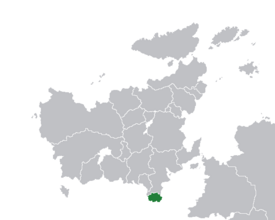Galenia
Republic of Galenia | |
|---|---|
Motto:
| |
| Anthem: Liberty "Liri" | |
 Location of Galenia (in light green), within Euclea (light grey) | |
 | |
| Capital and city | Kartha |
| Official languages | Galenian Novalian |
| Demonym(s) | Galenian |
| Government | Unitary presidential constitutional republic |
| Nertilian Bushaj | |
| Hershor Dreshaj | |
| Kthjellor Nexhipi | |
| Legislature | Asambleja Kombëtare |
| Area | |
• | 62,532 km2 (24,144 sq mi) |
| Population | |
• 2019 estimate | 11,428,245 |
| GDP (PPP) | estimate |
• Total | $265 billion |
• Per capita | $23,375 |
| GDP (nominal) | estimate |
• Total | $214 billion |
• Per capita | $20,028 |
| Gini | 42.4 medium |
| HDI | 0.796 high |
| Currency | Galenian Flori (GF$) |
| Date format | dd/mm/yyyy |
| Driving side | right |
Galenia, officially the Republic of Galenia (Galenian: Republika e Trekalërisë, Novalian: Republika Galenska, Piraese Galenikí Dimokratía), is a sovereign state whose territory is located in the Continent of Euclea, Kylaris. Galenia has a total area of 62,532 square kilometres and a population of 11,329,605 (as of January 2017). Galenia's only border is with Etruria to the north. The capital and most populous city is Kartha, located in the southwestern coast. Other important urban areas of the country includes Mbresht, Tallaz, Kufivalë, and Kallëm.
Galenia was originally inhabited by Gadishullorian Tribes, with the oldest found settlement dating back to the 8th BCE. During the 7th BCE, Lasithi took control over the peninsula, extending the Pirean territory further south. Following the War of the League of Maleme (272 - 259 BCE) and the Eruption at Juktas, the Galenian city-states unite under the leadership of three dominant Polis (Amphitrite, Kymo, Kymodoke), and formed the League of Galenia in 208 BCE. The League did not last long as the Solarian Empire took over the Galenian peninsula in around 90 CE. Following the Solarian Empire's fall, Galenia became a huge conglomerate of small, independent kingdoms. During the 7th century CE, important kingdoms like the Trekalërisë and the Karthë-Tallaz rose in the peninsula; during the same period of time, Marolevians started to migrate south through Novalia, inhabiting most of the northern portion of modern day Galenia. The Kingdom of Trekalërisë gradually took over the peninsula and established the Trekalërisë Empire, renamed as the Apolitan Empire following the Iconoclast Wars.
During the early 18th century, Vespasians defeated the Apolitan Empire and annexed the territory to Novalia. Galenia remained as a region of Novalia until 1879, when Apolitan priest Bujar Zogaj led the Galenian Uprising, proclaiming the independence of Galenia from Etruria. The separatist movement fails and is annexed back into Etruria only 2 months after. In March, 1880, the First Republican March saw thousands of people across the Mbresht-Kartha-Tallaz area protesting against the Etrurian monarchy and claiming independence. In 1888 the new Etrurian Republican regime promoted Galenia into a Federal Territory. It remained as such until 1930, when the Galenian Republican Army (URT) declares the Second Galenian Republic as independent from Etruria and it is promptly accepted into the Entente. However, the already mobilizied Etrurian military had no struggle containig the movement in 1931 and retaking Galenia as an Etrurian Territory. Independence only came in 1946, with the conclusion of the Solarian War.
Demographics
Largest cities in Galenia
2017 Census | |||||||||
|---|---|---|---|---|---|---|---|---|---|
| Rank | County | Pop. | |||||||
 Karthë  Mbresht |
1 | Karthë | x | 1,453,549 |  Tallaz  Kufivalë | ||||
| 2 | Mbresht | x | 848,840 | ||||||
| 3 | Tallaz | x | 764,617 | ||||||
| 4 | Kufivalë | x | 630,587 | ||||||
| 5 | Sorrë | x | 264,683 | ||||||
| 6 | Valqëndrush | x | 259,388 | ||||||
| 7 | Kallëm | x | 205,346 | ||||||
| 8 | Halinos | x | 189,652 | ||||||
| 9 | Kreshnik | x | 169,494 | ||||||
| 10 | Xehet | x | 137,029 | ||||||

